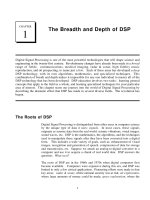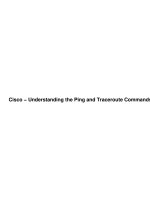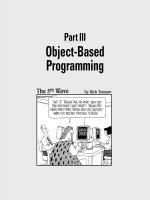Professional Website Performance: Optimizing the Front-End and Back-End potx
Bạn đang xem bản rút gọn của tài liệu. Xem và tải ngay bản đầy đủ của tài liệu tại đây (11.14 MB, 484 trang )
www.it-ebooks.info
ffirs.indd iiffirs.indd ii 05/11/12 5:02 PM05/11/12 5:02 PM
www.it-ebooks.info
PROFESSIONAL WEBSITE PERFORMANCE
INTRODUCTION . . . . . . . . . . . . . . . . . . . . . . . . . . . . . . . . . . . . . . . . . . . . . . . . . . . . . . . . . . . . xxiii
PART I FRONT END
CHAPTER 1 A Refresher on Web Browsers . . . . . . . . . . . . . . . . . . . . . . . . . . . . . . . . . . . . 3
CHAPTER 2 Utilizing Client-Side Caching . . . . . . . . . . . . . . . . . . . . . . . . . . . . . . . . . . . . 23
CHAPTER 3 Content Compression . . . . . . . . . . . . . . . . . . . . . . . . . . . . . . . . . . . . . . . . . . 39
CHAPTER 4 Keeping the Size Down with Minifi cation . . . . . . . . . . . . . . . . . . . . . . . . . 53
CHAPTER 5 Optimizing Web Graphics and CSS . . . . . . . . . . . . . . . . . . . . . . . . . . . . . . .71
CHAPTER 6 JavaScript, the Document Object Model, and Ajax . . . . . . . . . . . . . . . . . 111
PART II BACK END
CHAPTER 7 Working with Web Servers . . . . . . . . . . . . . . . . . . . . . . . . . . . . . . . . . . . . . . 141
CHAPTER 8 Tuning MySQL . . . . . . . . . . . . . . . . . . . . . . . . . . . . . . . . . . . . . . . . . . . . . . . 193
CHAPTER 9 MySQL in the Network . . . . . . . . . . . . . . . . . . . . . . . . . . . . . . . . . . . . . . . . 255
CHAPTER 10 Utilizing NoSQL Solutions . . . . . . . . . . . . . . . . . . . . . . . . . . . . . . . . . . . . . . 309
CHAPTER 11 Working with Secure Sockets Layer (SSL) . . . . . . . . . . . . . . . . . . . . . . . . 359
CHAPTER 12 Optimizing PHP. . . . . . . . . . . . . . . . . . . . . . . . . . . . . . . . . . . . . . . . . . . . . . . 375
PART III APPENDIXES
APPENDIX A TCP Performance . . . . . . . . . . . . . . . . . . . . . . . . . . . . . . . . . . . . . . . . . . . . . 405
APPENDIX B Designing for Mobile Platforms . . . . . . . . . . . . . . . . . . . . . . . . . . . . . . . . . 409
APPENDIX C Compression . . . . . . . . . . . . . . . . . . . . . . . . . . . . . . . . . . . . . . . . . . . . . . . . . .417
INDEX . . . . . . . . . . . . . . . . . . . . . . . . . . . . . . . . . . . . . . . . . . . . . . . . . . . . . . . . . . . . . . . . . . . . . 427
ffirs.indd iffirs.indd i 05/11/12 5:02 PM05/11/12 5:02 PM
www.it-ebooks.info
ffirs.indd iiffirs.indd ii 05/11/12 5:02 PM05/11/12 5:02 PM
www.it-ebooks.info
PROFESSIONAL
Website Performance
OPTIMIZING THE FRONT END AND THE BACK END
Peter Smith
John Wiley & Sons, Inc.
ffirs.indd iiiffirs.indd iii 05/11/12 5:02 PM05/11/12 5:02 PM
www.it-ebooks.info
Professional Website Performance: Optimizing the Front End and the Back End
Published by
John Wiley & Sons, Inc.
10475 Crosspoint Boulevard
Indianapolis, IN 46256
www.wiley.com
Copyright © 2013 by John Wiley & Sons, Inc., Indianapolis, Indiana
Published simultaneously in Canada
ISBN: 978-1-118-48752-5
ISBN: 978-1-118-48751-8 (ebk)
ISBN: 978-1-118-55172-1 (ebk)
ISBN: 978-1-118-55171-4 (ebk)
Manufactured in the United States of America
10 9 8 7 6 5 4 3 2 1
No part of this publication may be reproduced, stored in a retrieval system or transmitted in any form or by any means,
electronic, mechanical, photocopying, recording, scanning or otherwise, except as permitted under Sections 107 or 108
of the 1976 United States Copyright Act, without either the prior written permission of the Publisher, or authorization
through payment of the appropriate per-copy fee to the Copyright Clearance Center, 222 Rosewood Drive, Danvers,
MA 01923, (978) 750-8400, fax (978) 646-8600. Requests to the Publisher for permission should be addressed to the
Permissions Department, John Wiley & Sons, Inc., 111 River Street, Hoboken, NJ 07030, (201) 748-6011,
fax (201) 748-6008, or online at />Limit of Liability/Disclaimer of Warranty: The publisher and the author make no representations or warranties with
respect to the accuracy or completeness of the contents of this work and speci cally disclaim all warranties, including
without limitation warranties of tness for a particular purpose. No warranty may be created or extended by sales or
promotional materials. The advice and strategies contained herein may not be suitable for every situation. This work
is sold with the understanding that the publisher is not engaged in rendering legal, accounting, or other professional
services. If professional assistance is required, the services of a competent professional person should be sought. Neither
the publisher nor the author shall be liable for damages arising herefrom. The fact that an organization or Web site is
referred to in this work as a citation and/or a potential source of further information does not mean that the author or the
publisher endorses the information the organization or Web site may provide or recommendations it may make. Further,
readers should be aware that Internet Web sites listed in this work may have changed or disappeared between when this
work was written and when it is read.
For general information on our other products and services please contact our Customer Care Department within the
United States at (877) 762-2974, outside the United States at (317) 572-3993 or fax (317) 572-4002.
Wiley publishes in a variety of print and electronic formats and by print-on-demand. Some material included with standard
print versions of this book may not be included in e-books or in print-on-demand. If this book refers to media such as a CD
or DVD that is not included in the version you purchased, you may download this material at
http://booksupport
.wiley.com
. For more information about Wiley products, visit www.wiley.com.
Library of Congress Control Number: 2012949514
Trademarks: Wiley, the Wiley logo, Wrox, the Wrox logo, Programmer to Programmer, and related trade dress are trade-
marks or registered trademarks of John Wiley & Sons, Inc. and/or its af liates, in the United States and other countries,
and may not be used without written permission. All other trademarks are the property of their respective owners. John
Wiley & Sons, Inc., is not associated with any product or vendor mentioned in this book.
ffirs.indd ivffirs.indd iv 05/11/12 5:02 PM05/11/12 5:02 PM
www.it-ebooks.info
To my wife, Stef, and my parents
ffirs.indd vffirs.indd v 05/11/12 5:02 PM05/11/12 5:02 PM
www.it-ebooks.info
ffirs.indd viffirs.indd vi 05/11/12 5:02 PM05/11/12 5:02 PM
www.it-ebooks.info
ABOUT THE AUTHOR
PETER G. SMITH has been a full-time Linux consultant, web developer, and system administrator, with
a particular interest in performance for the past 13 years. Over the years, he has helped a wide range
of clients in areas such as front-end performance, load balancing and scalability, and database opti-
mization. Past open source projects include modules for Apache and OSCommerce, a cross-platform
IRC client, and contributions to The Linux Documentation Project (TLDP).
ABOUT THE TECHNICAL EDITOR
JOHN PELOQUIN is a software engineer with back-end and front-end experience ranging across
web applications of all sizes. Peloquin earned his B.A. in Mathematics from the University of
California at Berkeley, and is currently a lead engineer for a healthcare technology startup, where
he makes heavy use of MySQL, PHP, and JavaScript. He has edited Professional JavaScript for
Web Developers, 3rd Edition by Nicholas Zakas (Indianapolis: Wiley, 2012) and JavaScript
24-Hour Trainer by Jeremy McPeak (Indianapolis: Wiley, 2010). When he is not coding or col-
lecting errata, Peloquin is often found engaged in mathematics,
philosophy, or juggling.
ffirs.indd viiffirs.indd vii 05/11/12 5:02 PM05/11/12 5:02 PM
www.it-ebooks.info
ffirs.indd viiiffirs.indd viii 05/11/12 5:02 PM05/11/12 5:02 PM
www.it-ebooks.info
CREDITS
EXECUTIVE EDITOR
Carol Long
PROJECT EDITOR
Kevin Shafer
TECHNICAL EDITOR
John Peloquin
PRODUCTION EDITOR
Rosanna Volis
COPY EDITOR
San Dee Phillips
EDITORIAL MANAGER
Mary Beth Wakefi eld
FREELANCER EDITORIAL MANAGER
Rosemarie Graham
ASSOCIATE DIRECTOR OF MARKETING
David Mayhew
MARKETING MANAGER
Ashley Zurcher
BUSINESS MANAGER
Amy Knies
PRODUCTION MANAGER
Tim Tate
VICE PRESIDENT AND EXECUTIVE GROUP
PUBLISHER
Richard Swadley
VICE PRESIDENT AND EXECUTIVE PUBLISHER
Neil Edde
ASSOCIATE PUBLISHER
Jim Minatel
PROJECT COORDINATOR, COVER
Katie Crocker
PROOFREADER
Nancy Carrasco
INDEXER
Robert Swanson
COVER DESIGNER
Ryan Sneed
COVER IMAGE
© Henry Price / iStockphoto
ffirs.indd ixffirs.indd ix 05/11/12 5:02 PM05/11/12 5:02 PM
www.it-ebooks.info
ffirs.indd xffirs.indd x 05/11/12 5:02 PM05/11/12 5:02 PM
www.it-ebooks.info
ACKNOWLEDGMENTS
A LOT OF PEOPLE HAVE BEEN INVOLVED in making this book happen. I’d like to thank everyone at
Wiley for their hard work, especially Carol Long for having faith in my original idea and helping me
to develop it, and Kevin Shafer, my Project Editor, who patiently helped turn my manuscript into
a well-rounded book. Special thanks are also due to John Peloquin, whose technical review proved
invaluable.
I’d also like to take the opportunity to thank my friends and family for being so supportive over the
past few months.
ffirs.indd xiffirs.indd xi 05/11/12 5:02 PM05/11/12 5:02 PM
www.it-ebooks.info
ffirs.indd xiiffirs.indd xii 05/11/12 5:02 PM05/11/12 5:02 PM
www.it-ebooks.info
CONTENTS
INTRODUCTION xxiii
PART I: FRONT END
CHAPTER 1: A REFRESHER ON WEB BROWSERS 3
A Brief History of Web Browsers 3
Netscape Loses Its Dominance 4
The Growth of Firefox 4
The Present 5
Inside HTTP 5
The HyperText Transfer Protocol 5
HTTP Versions 8
Support for Virtual Hosting 9
Caching 9
How Browsers Download and Render Content 10
Rendering 11
Persistent Connections and Keep-Alive 12
Parallel Downloading 14
Summary 21
CHAPTER 2: UTILIZING CLIENTSIDE CACHING 23
Understanding the Types of Caching 23
Caching by Browsers 23
Intermediate Caches 24
Reverse Proxies 25
Controlling Caching 25
Conditional GETs 25
Utilizing Cache-Control and Expires Headers 28
Choosing Expiration Policies 30
Coping with Stale Content 30
How Not to Cache 31
Dealing with Intermediate Caches 31
Cache-Control Revisited 31
Caching HTTP Responses 32
The Shift in Browser Behavior 32
Using Alternative 3xx Codes 34
ftoc.indd xiiiftoc.indd xiii 05/11/12 5:22 PM05/11/12 5:22 PM
www.it-ebooks.info
xiv
CONTENTS
DNS Caching and Prefetching 34
The DNS Resolution Process 35
DNS Caching by the Browser 35
How DNS Lookups A ect Performance 36
DNS Prefetching 36
Controlling Prefetching 37
Summary 37
CHAPTER 3: CONTENT COMPRESSION 39
Who Uses Compression 39
Understanding How Compression Works 41
Compression Methods 42
Other Compression Methods 47
Transfer Encoding 48
Compression in PHP 49
Compressing PHP-Generated Pages 49
Compressing Other Resources 51
Summary 51
CHAPTER 4: KEEPING THE SIZE DOWN WITH MINIFICATION 53
JavaScript Minifi cation 54
YUI Compressor 55
Google Closure 56
Comparison of JavaScript Minifi ers 58
CSS Minifi cation 59
Use Shorthand 59
Grouping Selectors 60
CSS Minifi ers 60
Improving Compression 62
HTML Minifi cation 63
HTML Minifi cation Techniques 64
HTML Minifi cation Tools 66
Summary 69
CHAPTER 5: OPTIMIZING WEB GRAPHICS AND CSS 71
Understanding Image Formats 71
JPEG 72
GIF 72
PNG 73
SVG 73
ftoc.indd xivftoc.indd xiv 05/11/12 5:22 PM05/11/12 5:22 PM
www.it-ebooks.info
xv
CONTENTS
Optimizing Images 74
Image Editing Software 74
Choosing the Right Format 74
Interlacing and Progressive Rendering 75
PNG Optimization 77
GIF Optimization 80
JPEG Compression 80
Image Optimization Software 84
Data URIs 85
Favicons 85
Using Lazy Loading 87
Avoiding Empty src attributes 88
Using Image Maps 89
CSS Sprites 91
Sprite Strategies 94
Repeating Images 94
CSS Performance 99
CSS in the Document Head 100
Inline versus External 100
Link versus @import 100
Redundant Selectors 100
CSS Expressions 101
Selector Performance 102
Using Shorthand Properties 102
Inheritance and Default Values 104
Doing More with CSS 104
Looking Forward 109
MNG 109
APNG 109
JPEG 2000 110
Summary 110
CHAPTER 6: JAVASCRIPT, THE DOCUMENT OBJECT MODEL,
AND AJAX 111
JavaScript, JScript, and ECMAScript 112
A Brief History of JavaScript 112
JavaScript Engines 112
The Document Object Model 115
Manipulating the DOM 117
Refl owing and Repainting 117
Browser Queuing 119
ftoc.indd xvftoc.indd xv 05/11/12 5:22 PM05/11/12 5:22 PM
www.it-ebooks.info
xvi
CONTENTS
Event Delegation 119
Unobtrusive JavaScript 120
Memory Management 121
Getting the Most from JavaScript 122
Language Constructs 122
Loading JavaScript 127
Nonblocking of JavaScript Downloads 128
Merging, Splitting, and Inlining 130
Web Workers 134
Ajax 136
XMLHttpRequest 136
Using Ajax for Nonblocking of JavaScript 137
Server Responsiveness 137
Using Preemptive Loading 138
Ajax Frameworks 138
Summary 138
PART II: BACK END
CHAPTER 7: WORKING WITH WEB SERVERS 141
Apache 141
Working with Modules 142
Deciding on Concurrency 145
Improving Logging 146
Miscellaneous Performance Considerations 148
Examining Caching Options 150
Using Content Compression 155
Looking Beyond Apache 158
Nginx 158
Nginx, Apache, and PHP 164
The Best of the Rest 168
Multiserver Setups with Nginx and Apache 169
Nginx as a Reverse Proxy to Apache 170
Proxy Options 171
Nginx and Apache Side by Side 172
Load Balancers 173
Hardware versus Software 173
Load Balancer Features 174
Using Multiple Back-End Servers 176
HAProxy 181
Summary 191
ftoc.indd xviftoc.indd xvi 05/11/12 5:22 PM05/11/12 5:22 PM
www.it-ebooks.info
xvii
CONTENTS
CHAPTER 8: TUNING MYSQL 193
Looking Inside MySQL 194
Understanding the Storage Engines 195
MyISAM 195
InnoDB 196
MEMORY 197
ARCHIVE 198
Tuning MySQL 198
Table Cache 198
Thread Caching 202
Per-Session Bu ers 204
Tuning MyISAM 205
Key Cache 205
Miscellaneous Tuning Options 210
Tuning InnoDB 211
Monitoring InnoDB 211
Working with Bu ers and Caches 212
Working with File Formats and Structures 217
Memory Allocation 218
Threading 219
Disk I/O 219
Mutexes 222
Compression 223
Working with the Query Cache 225
Understanding How the Query Cache Works 225
Confi guring the Query Cache 227
Inspecting the Cache 228
The Downsides of Query Caching 232
Optimizing SQL 234
EXPLAIN Explained 234
The Slow Query Log 237
Indexing 239
Query Execution and Optimization 247
Query Cost 248
Tips for SQL E ciency 249
Summary 254
CHAPTER 9: MYSQL IN THE NETWORK 255
Using Replication 256
The Basics 256
ftoc.indd xviiftoc.indd xvii 05/11/12 5:22 PM05/11/12 5:22 PM
www.it-ebooks.info
xviii
CONTENTS
Advanced Topologies 264
Replication Performance 270
Miscellaneous Features of Replication 273
Partitioning 273
Creating Partitions 274
Deciding How to Partition 276
Partition Pruning 276
Physical Storage of Partitions 277
Partition Management 278
Pros and Cons of Partitioning 278
Sharding 279
Lookup Tables 280
Fixed Sharding 281
Shard Sizes and Distribution 281
Sharding Keys and Accessibility 281
Cross-Shard Joins 282
Application Modifi cations 283
Complementing MySQL 283
MySQL Proxy 283
MySQL Tools 286
Alternatives to MySQL 294
MySQL Forks and Branches 294
Full-Text Searching 296
Other RDBMSs 307
Summary 308
CHAPTER 10: UTILIZING NOSQL SOLUTIONS 309
NoSQL Flavors 310
Key-Value Stores 310
Multidimension Stores 310
Document Stores 311
memcache 311
Installing and Running 312
membase — memcache with Persistent Storage 321
MongoDB 325
Getting to Know MongoDB 325
MongoDB Performance 328
Replication 339
Sharding 343
Other NoSQL Technologies 353
Tokyo Cabinet and Tokyo Tyrant 354
CouchDB 354
ftoc.indd xviiiftoc.indd xviii 05/11/12 5:22 PM05/11/12 5:22 PM
www.it-ebooks.info
xix
CONTENTS
Project Voldemort 355
Amazon Dynamo and Google BigTable 355
Riak 356
Cassandra 356
Redis 356
HBase 356
Summary 356
CHAPTER 11: WORKING WITH SECURE SOCKETS LAYER SSL 359
SSL Caching 360
Connections, Sessions, and Handshakes 360
Abbreviated Handshakes 360
SSL Termination and Endpoints 364
SSL Termination with Nginx 365
SSL Termination with Apache 366
SSL Termination with stunnel 367
SSL Termination with stud 368
Sending Intermediate Certifi cates 368
Determining Key Sizes 369
Selecting Cipher Suites 369
Investing in Hardware Acceleration 371
The Future of SSL 371
OCSP Stapling 371
False Start 372
Summary 372
CHAPTER 12: OPTIMIZING PHP 375
Extensions and Compiling 376
Removing Unneeded Extensions 376
Writing Your Own PHP Extensions 378
Compiling 379
Opcode Caching 381
Variations of Opcode Caches 381
Getting to Know APC 382
Memory Management 382
Optimization 382
Time-To-Live (TTL) 382
Locking 383
Sample apc.ini 384
APC Caching Strategies 384
Monitoring the Cache 386
Using APC as a Generic Cache 386
ftoc.indd xixftoc.indd xix 05/11/12 5:22 PM05/11/12 5:22 PM
www.it-ebooks.info
xx
CONTENTS
Warming the Cache 387
Using APC with FastCGI 387
Compiling PHP 388
phc 388
Phalanger 388
HipHop 388
Sessions 389
Storing Sessions 389
Storing Sessions in memcache/membase 390
Using Shared Memory or tmpfs 390
Session AutoStart 391
Sessions and Caching 391
E cient PHP Programming 392
Minor Optimizations 392
Major Optimizations 392
Garbage Collection 395
Autoloading Classes 396
Persistent MySQL Connections 396
Profi ling with xhprof 398
Installing 398
A Simple Example 399
Don’t Use PHP 401
Summary 401
PART III: APPENDIXES
APPENDIX A: TCP PERFORMANCE 405
The Three-Way Handshake 405
TCP Performance 408
Nagle’s Algorithm 408
TCP_NOPUSH and TCP_CORK 408
APPENDIX B: DESIGNING FOR MOBILE PLATFORMS 409
Understanding Mobile Platforms 409
Responsive Content 410
Getting Browser Display Capabilities with JavaScript 411
Server-Side Detection of Capabilities 411
A Combined Approach 412
CSS3 Media Queries 413
Determining Connection Speed 413
ftoc.indd xxftoc.indd xx 05/11/12 5:22 PM05/11/12 5:22 PM
www.it-ebooks.info
xxi
CONTENTS
JavaScript and CSS Compatibility 414
Caching in Mobile Devices 414
APPENDIX C: COMPRESSION 417
The LZW Family 417
LZ77 417
LZ78 418
LZW 419
LZ Derivatives 420
Hu man Encoding 421
Compression Implementations 424
INDEX 427
ftoc.indd xxiftoc.indd xxi 05/11/12 5:22 PM05/11/12 5:22 PM
www.it-ebooks.info
flast.indd xxiiflast.indd xxii 05/11/12 4:57 PM05/11/12 4:57 PM
www.it-ebooks.info
INTRODUCTION
THE PAST DECADE has seen an increased interest in website performance, with businesses of all
sizes realizing that even modest changes in page loading times can have a signi cant effect on their
pro ts. The move toward a faster web has been driven largely by Yahoo! and Google, which have
both carried out extensive research on the subject of website performance, and have worked hard to
make web masters aware of the bene ts.
This book provides valuable information that you must know about website performance
optimization — from database replication and web server load balancing, to JavaScript pro ling
and the latest features of Cascading Style Sheets 3 (CSS3). You can discover (perhaps surprising)
ways in which your website is under-performing, and learn how to scale out your system as the
popularity of your site increases.
WHY SPEED IS IMPORTANT
At rst glance, it may seem as if website loading speeds aren’t terribly important. Of course, it puts
off users if they must wait 30 seconds for your page to load. But if loading times are relatively low,
isn’t that enough? Does shaving off a couple of seconds from loading times actually make that much
of a difference? Numerous pieces of research have been carried out on this subject, and the results
are quite surprising.
In 2006, Google experimented with reducing the size of its Maps homepage (from 100 KB to
70–80 KB). Within a week, traf c had increased by 10 percent, according to ZDNet (
http://www
.zdnet.com/blog/btl/googles-marissa-mayer-speed-wins/3925?p=3925
). Google also found
that a half-second increase in loading times for search results had led to a 20 percent drop in sales.
That same year, Amazon.com came to similar conclusions, after experiments showed that for each
100-millisecond increase in loading time, sales dropped by 1 percent (
nford
.edu/~ronnyk/IEEEComputer2007OnlineExperiments.pdf
).
The fact that there is a correlation between speed and sales perhaps isn’t too surprising, but the
extent to which even a tiny difference in loading times can have such a noticeable impact on sales
certainly is.
But that’s not the only worry. Not only do slow websites lose traf c and sales, work at Stanford
University suggests that slow websites are also considered less credible (
http://captology
.stanford.edu/pdf/p61-fogg.pdf
). It seems that, as Internet connections have become faster, the
willingness of users to wait has started to wane. If you want your site to be busy and well liked, it
pays to be fast.
flast.indd xxiiiflast.indd xxiii 05/11/12 4:57 PM05/11/12 4:57 PM
www.it-ebooks.info









